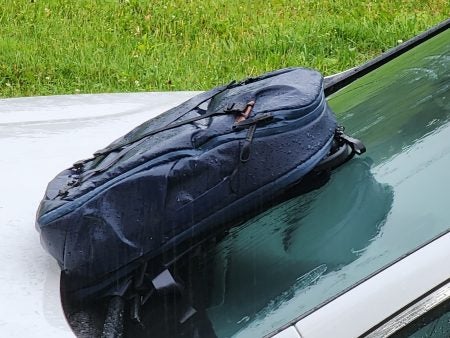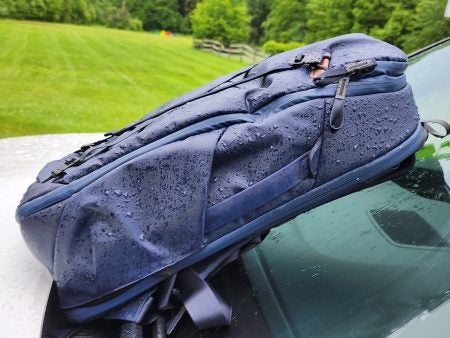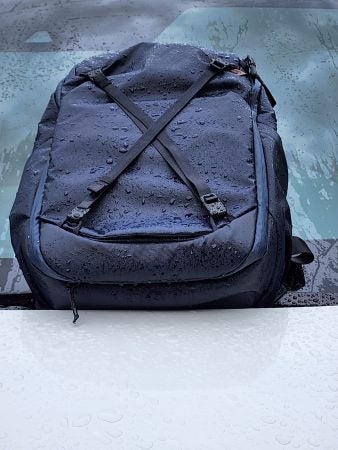For motorcyclists, fun is only one of the reasons to ride their bikes. Sometimes riders use two-wheelers for daily transportation, including getting back and forth from work and completing errands.
While you are out and about doing those daily tasks, you might want to take some things with you or bring something back. For ease of use and pure simplicity, a backpack can be a good idea. So when Peak Design offered me the opportunity to try out their 30-liter Travel Backpack, I thought I’d give it a try to see whether it could be a good solution for those everyday tasks.
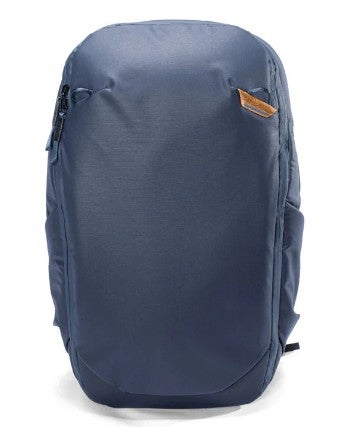
The Peak Design 30-liter travel backpack. Photo: Peak Design
Although this particular backpack was designed mainly as a camera tote, it seemed that it could do double duty as a commuter pack. It has some design features that offer motorcyclists some excellent capabilities, but perhaps not in the form that riders may be used to. So, let’s dive in, shall we?
TL/DR
The Too Long/Didn’t Read summary is the Peak Design 30-liter Travel Backpack is a well-engineered, spacious, and well-constructed backpack capable of carrying many things that riders might need for the day or even a few days. Some of its features are pretty standard, but the backpack’s details set it apart from many others.
Lots and lots of storage
If there’s one thing to be said about the backpack, there is plenty of storage inside and out. While there is loose storage space, plenty of secured zippered compartments will keep your things where you put them. You won’t have to fish around looking for them; they will be where you put them.
Exterior storage
The outside of the pack has six storage compartments. Frankly, at first glimpse, it doesn’t look like there are six since they are integrated so nicely. At the top of the pack is a small zippered storage compartment.

This pocket is accessible from the outside of the pack and nicely held my laptop accessories. Photo: Mike Botan
This small compartment was big enough to hold my laptop’s mouse, power pack and cord, a portable hard drive, a USB hub, and some SD cards with room to spare. It also has a small zippered storage area to hold your small loose items securely.
While we are on the topic of external zippers, all the exterior zippers use the same heavy-duty, fine-toothed, #10 zipper water-resistant zippers. They are smooth to the touch and close very smoothly without being “fussy.”
The main compartment zipper has two “lockable” pulls that keep the two pulls together, making it more difficult for thieves to unzip the bag and get to its contents quickly.

Just a little extra security. The backpack’s main compartment pull tabs interlock. They won’t stop determined thieves but could help if someone tries to open the pack without you noticing it. Photo: Mike Botan
Lashing straps
The pack comes with two removable and adjustable lashing straps that attach to loops on the pack’s exterior. You can use them to attach an item to the outside of the backpack that you don’t wish to carry internally.
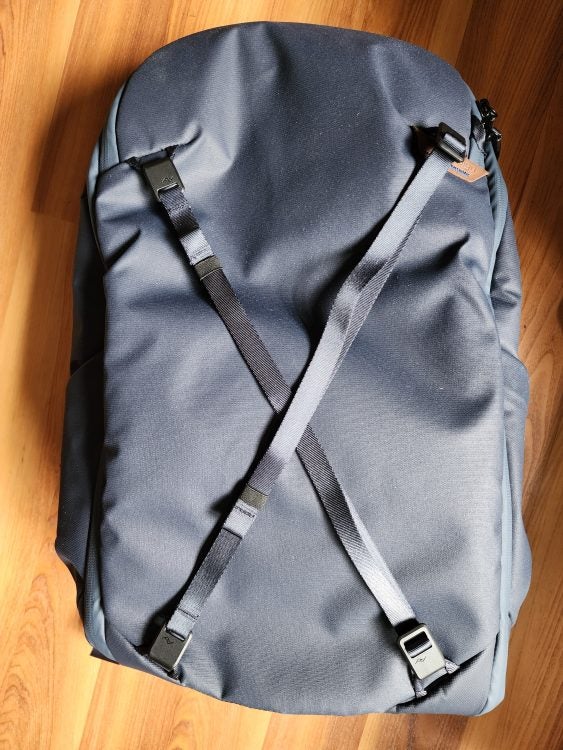
Two removable lashing straps attach to built-in loops. Photo: Mike Botan
Interior storage
Access to the main interior compartment is by a zipper that travels from the top of the pack to the very bottom of both sides. Once unzipped, the back of the pack opens, revealing all of the contents inside.
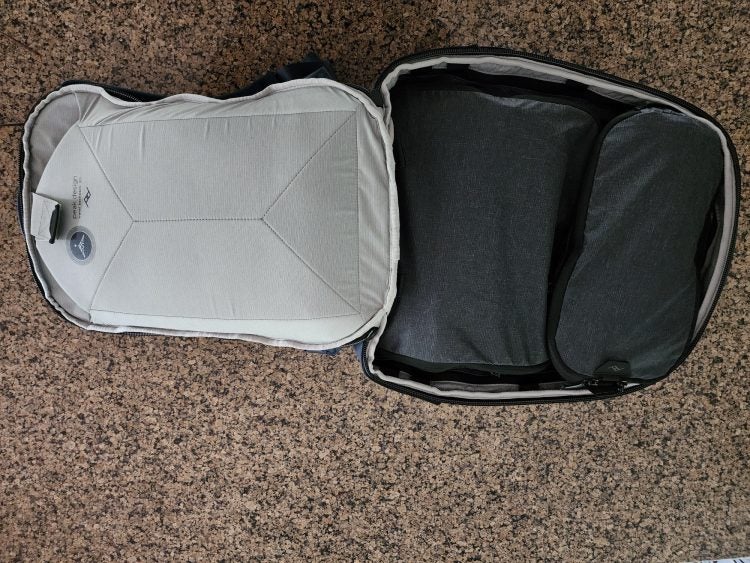
The open main compartment with two of Peak’s packing cubes inside. Photo: Mike Botan
Because there are stiffeners in the pack, all your contents stay in place, and you can quickly see everything. It’s a somewhat different approach, but one that gives you a great view of what you put inside. At the same time, if it’s raining and you want to open the bag fully, you will need to find some cover to keep the contents from getting wet.
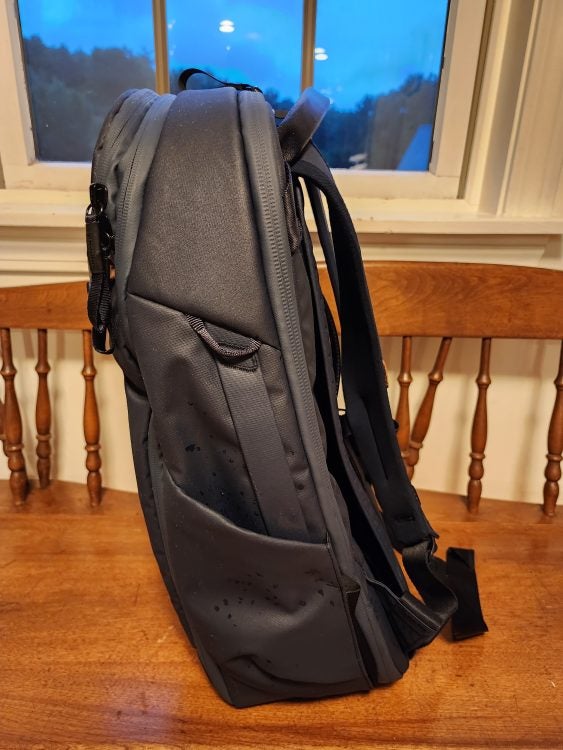
Even unpacked, the backpack retains its shape. Photo: Mike Botan
Inside the interior storage are four separate zippered compartments; two smaller ones at the side of the pack and two larger ones on the pack’s face. Each can hold a significant amount of gear and keep it in place.
Laptop storage
The interior storage area also has dedicated spots for a laptop and a tablet. It will hold a laptop up to 15.75″ x 11.6″ x 1.6″ (40cm x 29.5cm x 4cm ) as well as a tablet up to 9.5″ x 7.5″ x 0.6″ (24cm x 19cm x 1.5cm).
The storage compartment is placed near the back of the pack against your back. Its placement allows you to access the laptop compartment without completely opening the pack and may provide additional cushioning in case of a fall off the bike.
For this review, I could insert my Surface Pro 10 still wrapped in its rubberized carry case and had plenty of room to spare. Ultimately, the laptop compartment can hold:
Laptop: 15.75″ x 11.6″ x 1.6″ (40cm x 29.5cm x 4cm)
Tablet: 9.5″ x 7.5″ x 0.6″ (24cm x 19cm x 1.5cm)
Even more space
If 30 liters of storage space is not enough, the pack is also expandable using a zipper that runs around the pack’s top and sides. When expanded, you will get an additional 3 liters of storage space.
On the other end of the spectrum, the pack sports deployable compression straps if you don’t need the full 30 liters.
ID compartment
There is also a well-hidden small compartment on the side of the pack that secures with velcro. It’s sized to hold things like your ID or other small items.
Expandable side pockets
On each side of the pack is a small elasticated storage compartment that can carry items like a water bottle or small tripod. While these pockets can hold such things, nothing secures them, so you’ll have to decide whether the inserted item is secure enough to ride with. It would have been nice if Peak had placed a small strap or other retention devices to hold the items securely. But again, this pack was designed as a camera travel pack, not as an off-road carry system.
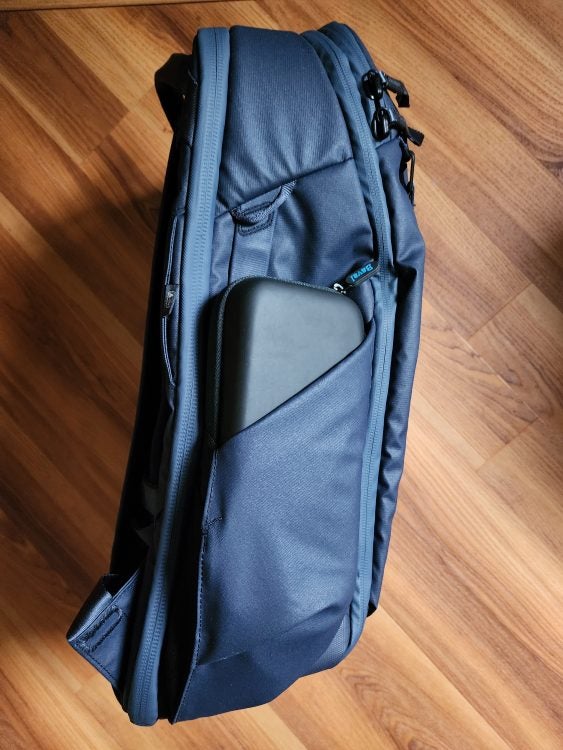
My computer accessories case fit snugly inside one of the backpack’s side pockets. Photo: Mike Botan
Finally, two separate compartments on the back of the pack allow you to stash its shoulder straps when not needed. In place of the shoulder straps, you can use one of the five carry handles on the pack’s top, bottom, back, and sides. The back carrying strap can also function as a luggage pass-through so that you can easily attach it to a roller bag.
Wearing the pack
The backpack has two traditional padded shoulder straps. They are wide enough to spread the pack’s weight and narrow enough to not make them uncomfortable or restrict your movement while riding.
Putting on and taking off the pack is easy. Both straps are one-hand adjustable with no finicky plastic buckles. A metal buckle allows you to correctly size the pack to your body with a nicely placed pull.

The two shoulder straps and the chest strap can be stowed under the back of the backpack. Photo: Mike Botan
To keep the straps together, there’s also a one-hand placeable/removable chest strap that holds the two shoulder straps where you want them. It sits a little high on the shoulder straps, and I think it would be better if they were placed a little lower on the chest.
Unloaded, the pack weighs in at 3.17 lbs or 1.44 kg. That’s not bad for a day-to-day backpack with Peak’s features.
Holds its shape
The pack has a 100% recycled 400-denier nylon canvas shell and a 900-denier bottom liner. It also has internal stiffeners, which help the bag maintain its shape. When you place the pack on a hard surface, it will retain its shape, even when only partially filled.

The backpack holds its shape even when empty. Photo: Mike Botan
The stiffeners also have the additional benefit of making the bag more stable so that the items stored inside are less likely to poke out or shift position as you ride. And, for riders, the stiffeners also create an excellent rounded shape so the bag won’t flap in the wind.
Water resistance
Peak Design does not claim that the 30-liter travel backpack is waterproof. But they say it has a water-resistant design, so I decided to test just how water-resistant it is.
To see whether the pack’s interior would leak, I used three of Peak Design’s optional packing cubes, some packing bubble wrap, and some lightweight, unprinted wrapping paper. Inside each of the packing cubes, I placed the bubble wrap and a sheet of wrapping paper. Then I placed a sheet of wrapping paper on top of everything inside and closed the pack.
If water got inside, the wrapping paper would quickly get soggy and wet. And if the water penetrated the packing cubes, the wrapping paper inside them would show how much moisture entered.
I then put the backpack outside in the rain (actually downpours and thunderstorms) for over two hours. After the rain stopped, I retrieved the backpack, wiped down the exterior, and opened it.
- The backpack in the pouring rain sitting on the windshield of my truck. Photo: Mike Botan
- Rain over, the wet backpack. Photo: Mike Botan
- The soon to be opened backpack. Photo: Mike Botan
Perhaps surprisingly, the wrapping paper was completely dry. In addition, none of the packing cubes were wet, nor was there any moisture inside them. As a result, I suggest that the pack deserves its water-resistant claims.

This wrapping paper would show whether any water entered the backpack. Photo: Mike Botan
Dimensions
The Peak 30-liter travel backpack has a “middle-of-the-road” size. If you use it as an airline carry-on, it should fit under the seat in front of you. Its external dimensions are:
Standard: 20.9″ x 13.4″ x 7″ (53cm x 34cm x 18cm)
Expanded: 20.9″ x 13.4″ x 7.9″ (53cm x 34cm x 20cm)
Internal dimensions are as follows:
Standard: 19.3″ x 13″ x 5.5” (49cm x 33cm x 14cm)
Expanded: 19.3″ x 13″ x 6.3” (49cm x 33cm x 16cm)
Other tidbits
The Peak 30-liter travel backpack is available in 3 colors, black, sage (green), and midnight (blue). It’s also guaranteed for life, made from recycled plastic, and fair trade certified. Finally, Peak says that the pack is also 100% carbon neutral.
Pricing
Peak’s 30-liter travel backpack has an MSRP of $229.95. That pricing puts it in line with other high-quality travel backpacks. There are cheaper backpacks out there, but this quality piece of kit is guaranteed for life.
Summary
I like Peak’s travel backpack. It’s probably the best lightweight travel backpack I have ever owned. It was not designed to be an off-roading carry pack, but I think the Peak 30-liter backpack is a high-quality piece of kit sized just right for the daily moto commuter. And with just a few changes, Peak could make this pack into a trail-ready backpack. But for moto commuting, the pack is just fine as it is.


